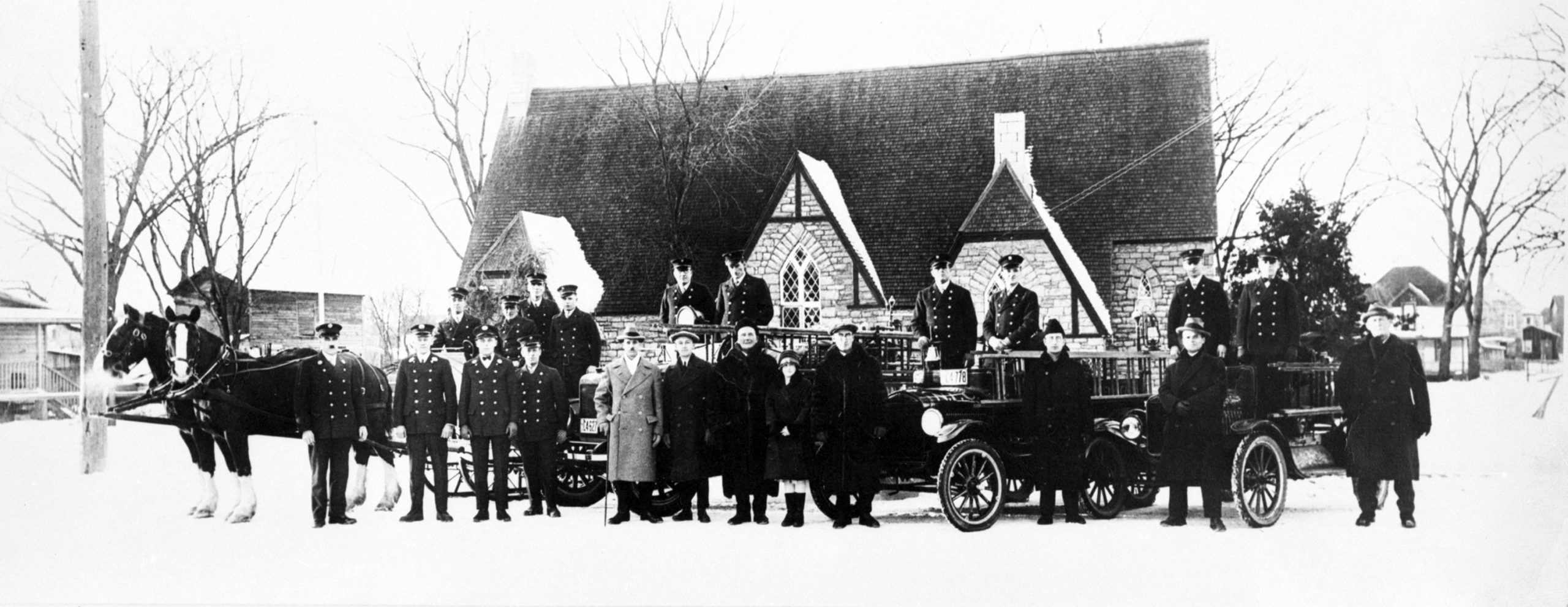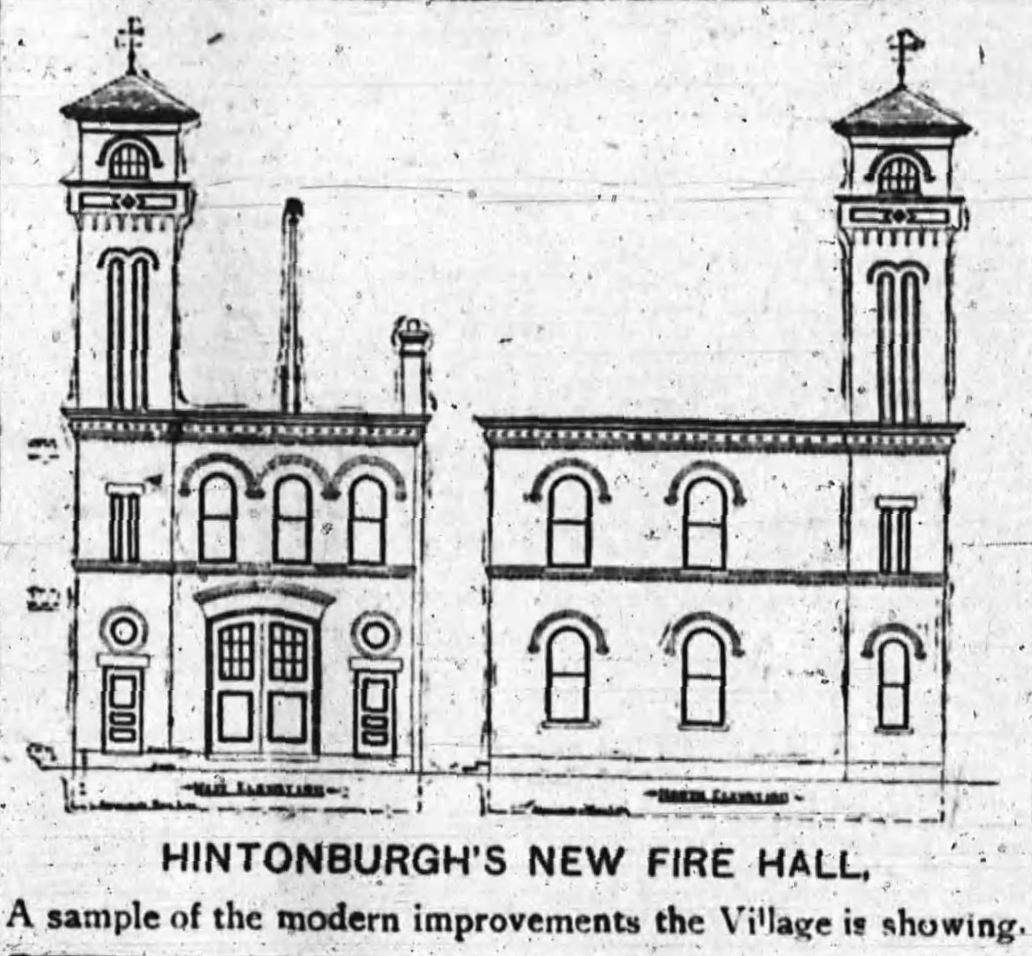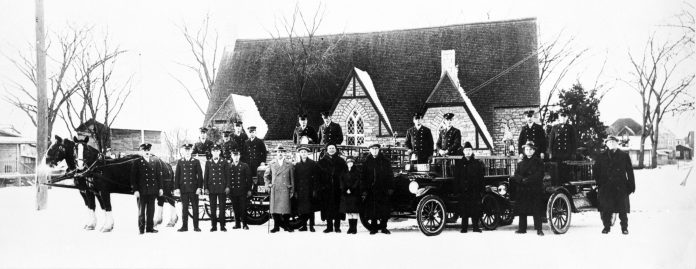By Dave Allston –
It’s hard to believe, but Kitchissippi is one of the few wards in Ottawa without a fire station. It hasn’t always been that way, however. Local fire fighting has a history as old as the neighbourhoods themselves. Over time, Kitchissippi has been well served by local fire companies that grew from volunteer bucket brigades to small stations with a horse and a hose, to full-sized fire halls with increasingly modern equipment. The closure of the Parkdale and Churchill Avenue stations in November 1985 sadly signaled the end of the community fire stations in Hintonburg and Westboro.
Until the early 1900s, citizens were ill-equipped to put out a fire if it burned out of control. Buildings were mostly wood-frame shacks and in some areas – like Mechanicsville – were built very close together. Under these conditions, a fire quickly became destructive and deadly. At the very least, bucket brigades using water from local wells, creeks, or the Ottawa River may have prevented fire from spreading, if they were lucky. Essentially, west-enders were on their own. (As a result, it was almost impossible to obtain house insurance.)
After Hintonburg constructed an expensive, elaborate waterworks system in 1899, the next step was to establish a fire-fighting strategy. A fire brigade was organized in January 1900, with 40 volunteers split into two divisions: a daytime brigade composed of village merchants and a night brigade of working men who resided in Hintonburg. A hose reel was purchased, and a house for its storage was built by the village council on Wellington Street near the corner of Fairmont. The keys to this house were kept in three locations: at James Byers’ tavern, at Village Clerk Mason’s house, and on the key ring of Police Constable Morgan. James Byers was also Chief of the Brigade, and James A. Forward was Captain.

The brigade purchased rubber coats, boots, pails, lanterns, and ladders. The hose reel was placed on runners, to be pulled by Byers’ horses when a call arrived. The brigade held practices in mid-February and drafted bylaws in March. Then, in late April, the great Hull-Ottawa fire struck. Hintonburg was largely unaffected but it further underlined the need for fire protection in the village.

Hydrants were installed throughout 1900 and waterworks were extended by Hintonburg as far west as Ross Avenue over the winter of 1900-01. In its first year, the brigade battled 12 fires. When a fire was discovered, those first on the scene started a bucket brigade, and a messenger was sent out to alert members who would bring the hose reel to the fire.
In August 1901, tenders called for construction of a new fire hall on Fairmont Avenue. Designed by E.L. Horwood, it was built by Villeneuve Bros. of Hintonburg at a cost of $2,025. Poles were installed throughout Hintonburg and into Nepean for the fire alarm system, which was powered by batteries. Herbert Moodie was hired as battery inspector for $5 monthly.
The new station opened for service on December 5, 1901. When Hintonburg joined Ottawa in 1907, it became Ottawa Station 11, a number which stuck for the next 78 years. It remained in operation until 1924, when it was deemed too dilapidated. It was renovated and repurposed as a police station, and later, a funeral parlor. Amazingly, this building still stands today at 7 Fairmont as Forbes Beauty Co., though most of the features of the fire department are long gone.
The new station on Parkdale Avenue, designed by architect Millson, Burgess, and Hazelgrove, opened on July 28, 1924, under the charge of Captain Stephen Starr.
Meanwhile, in Westboro, a brigade of 25 volunteers was finally organized at a meeting in Nepean Town Hall on September 3, 1913. Paddy Mears was elected as the first Chief. Westboro Village council provided the first apparatus, a water tank, and wagon, and the brigade used a portion of the town hall shed as their headquarters. Leander Henderson rigged up a primitive alarm in the form of a large circular saw that was mounted on top of the shed, which could be activated by a rope. When the alarm sounded, volunteers rushed to the shed. The first to hitch his team of horses to the wagon received five dollars. A year later, the village purchased a hand-drawn chemical engine, which was later replaced by a Ford truck.
In 1916, the bell and belfry to summon the fire fighters were added to Nepean town hall at the request of the brigade. Village council approved the fee of $175 be paid to W.J. Hamilton to construct the tower and install the bell, which later became Nepean’s iconic logo.
The brigade later rented a large rustic building on the east side of Churchill, just north of Richmond, which became the first “station.” Soon the Westboro brigade was fighting fires throughout Nepean Township, and marshals were appointed to conduct building inspections.


In 1923, Chief W.G.H. Cummings became the first to be paid a salary. By then, Westboro had three trucks and a horse-drawn vehicle for winter use. The brigade received about 100 calls a year, which doubled by the mid-1930s.
Water service and hydrants were installed in Westboro during the depression, partially to provide work to residents.
The new Churchill Avenue fire hall, built behind the town hall along Madison Avenue, opened August 30, 1939. Designed by William Abra, it was built very economically by F. E. Cummings for a mere $9,000 using local materials, with many of the volunteer firemen contributing labour. It had space for three trucks, plus an office, locker room, recreation room, and basement workshop. The new station and waterworks led to a boom in industry coming to Westboro.
By the mid-1940s, Nepean began to pay their firemen, and once Nepean joined the City of Ottawa in 1950, there were few volunteers remaining. Adding to the community feel, the station was largely staffed by Westboro residents.
In 1982, Ottawa conducted a fire station relocation project, designating seven of them surplus, while planning construction of eight new stations at more strategic locations, at a cost of $14M. Both Kitchissippi fire halls were deemed to be in poor condition, and Parkdale was criticized for slow response times due to the Queensway ramps. Both closed in November 1985.
The Churchill fire hall was used briefly as extra space for the seniors’ recreation group Churchill Club until demolished in the early ‘90s. A massive $15M 120,000 square foot commercial-residential development partnership between All Saints and the City (including a 12-storey observation tower) failed. The old town hall was later expanded to a smaller degree. The former fire hall location remains a parking lot.
Parkdale fire hall was used as office space by the Grace Hospital, Salvation Army Snowsuit Fund, Bridgehead, and the Parkdale Food Centre, before a major renovation in 2004-2005. As one of the last pre-1930 stations remaining in Ottawa, the hall received heritage designation in 1996. It continues today as Urban Element, but more importantly, as a local landmark that connects the neighbourhood back nearly 100 years to the early days of fire fighting in Kitchissippi.
Dave Allston is a local historian and the author of a blog called The Kitchissippi Museum. His family has lived in Kitchissippi for six generations. Do you have memories of the fire brigade? We’d love to hear them! Send your email to stories@kitchissippi.com.
